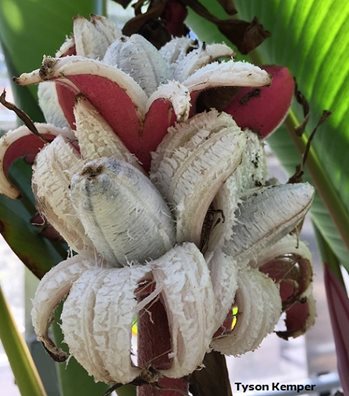Pink/Hairy Banana
Musa sp. – cultivated bananas
Morphology

The cultivated banana plant is a tall (2-9 m) perennial herb. The above ‘trunk’ is called a pseudostem and consists of concentric layers of leaf sheaths rolled into a cylinder 20-50 cm diameter. The leaves emerge, tightly rolled, from the center of the pseudostem in an anti-clockwise spiral manner.
Plant Growth
It takes between nine and 12 months for a banana plant to produce a flower after being planted and another two or three months for the banana to ripen.
Distribution
First known instance of banana domestication came from Southeast Asia and the South Pacific. However, they are grown in at least 107 countries today.
Habitat
Bananas need rich, dark soils with lots of nitrogen. Steady warmth and moisture are necessary for survival.
Reproduction
Cultivated bananas reproduces asexually; replanting a small plant called “suckers” propagates them. There emerges a large flower spike with numerous individual flowers that bend over becoming edible fruits. The main yellow banana sold in grocery stores across the world is a cultivar called Cavendish, propagated with the suckers method. Until the 1950s, main market bananas were a variety called Gros Michel, a sweeter and better tasting banana. Because they were also a mono-culture (clones and nearly identical to each other) they suffered from a world-wide banana blight. The Cavendish banana has replaced them.
Other Information:
Pharmacological properties: Bananas provide a variety of vitamins and minerals: vitamin B6, manganese, vitamin C, potassium, dietary fiber, protein, magnesium, folate, riboflavin, niacin, vitamin A, and iron
Medicinal effects: Possible health benefits include: Maintaining blood pressure, improve asthma symptoms, may reduce risk of developing leukemia, and support heart health.
Toxicological effects: High potassium foods such as bananas should be consumed in moderation when people are on beta-blockers. Consuming too much potassium can also be harmful for those whose kidneys are not fully functional.
Other Uses: Eating, cooking, fertilizer, attract birds & butterflies, polish leather. Many nations in tropical areas use banana leaves to wrap and cook/steam food. In east Mexico and Central America, tamales are wrapped in banana leaves instead of the traditional corn husks used by west/central Mexico.
Musa velutina – Hairy banana, Pink banana
The pink banana has a hairy, pink peel and are shorter and stubbier than the Cavendish banana. Flowers are also pink. While on the stalk, the banana peel will open up like a star and expose the white fruit while still attached to the stalk. Unlike the clonal Cavendish banana, the pink banana still has seeds. These can be cleaned, dried, and replanted for new plants.
Citations
- https://www.tropicalpermaculture.com/growing-bananas.html
- http://www.ogtr.gov.au/internet/ogtr/publishing.nsf/content/banana-3/$FILE/biologybanana.pdf
- http://www.medicalnewstoday.com/articles/271157.php
- http://theconversation.com/the-quest-to-save-the-banana-from-extinction-112256
- https://davesgarden.com/guides/pf/go/979/#b
This article was contributed by Brandon Yadi (BBIO 220 SUM’15) and Sarah Verlinde. For questions regarding the UWB/CC Plant Tour, contact Sarah at severlin@uw.edu.
